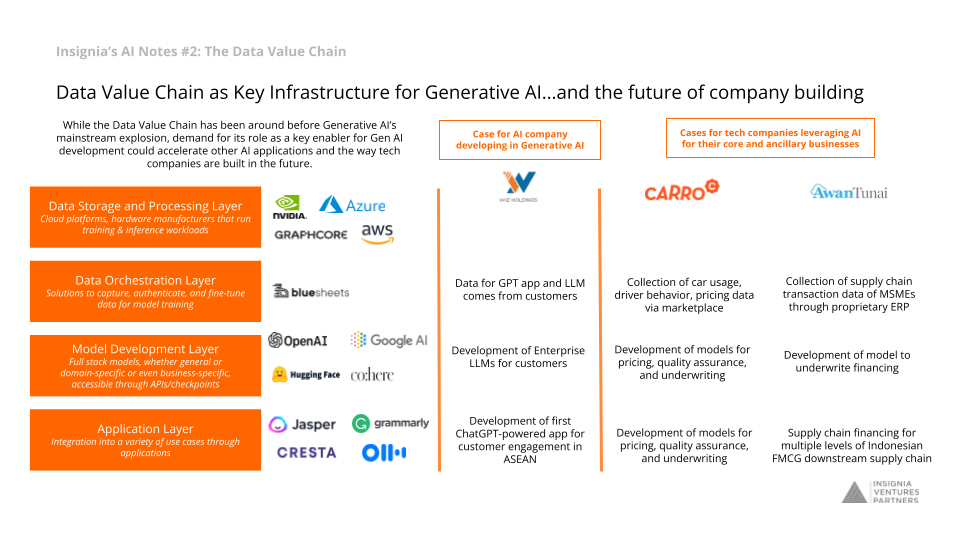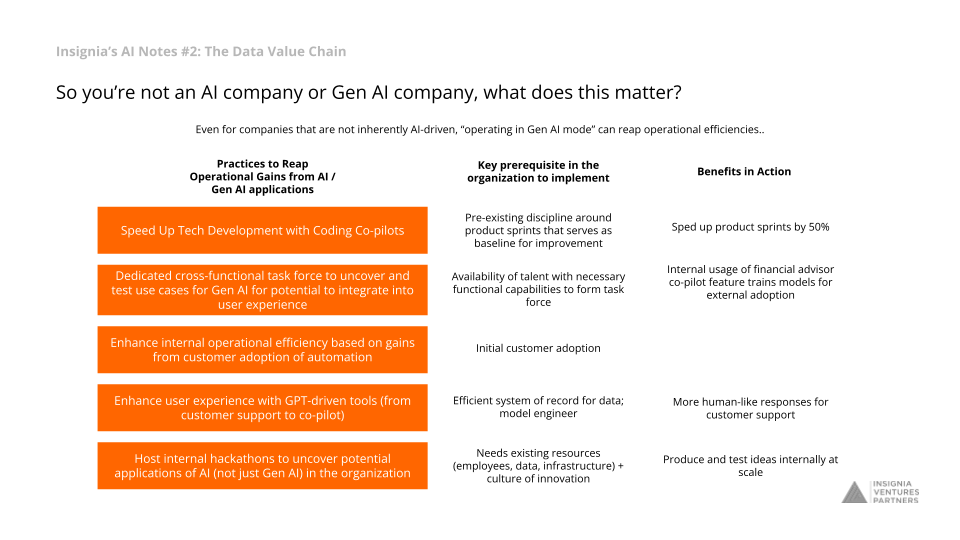In the previous article, we discussed the transformational potential of Generative AI (Gen AI) for human productivity. Now, we delve into the underpinning mechanism of this technological revolution: the data value chain. Understanding its centrality in Gen AI’s operation and development is essential, as well as recognizing its ongoing development for other AI applications.
The Data Value Chain: The Keystone of Generative AI

Gen AI’s burgeoning potential has made it increasingly clear that the ability to harness high-quality datasets is integral to developing AI models and applications. This is where the data value chain comes into play: It forms the critical infrastructure for Gen AI.
The data value chain encompasses four crucial layers:
- Infrastructure Layer: This layer includes 5G networks, cloud platforms, and hardware manufacturers handling training and inference workloads. A robust infrastructure ensures the resilient deployment of Gen AI applications.
- Orchestration Layer: This layer captures and fine-tunes data for model training, overseeing the management and processing of data.
- Foundational Layer: This layer produces AI models, whether general, domain-specific, or business-specific, typically accessible via APIs/checkpoints.
- Application Layer: This layer integrates the AI models into various applications for a range of use cases.
A striking example of the data value chain’s implementation in Gen AI is WIZ.AI. They launched the first ChatGPT-powered solution, TalkGPT, for customer engagement. The firm later unveiled an Enterprise LLM, enabling businesses to design, train, and implement their customized AI co-pilots. WIZ.AI exemplifies how the data value chain operates in Gen AI, from developing a robust infrastructure to applying AI models in real-world scenarios.
Data Value Chain: An Evolving Framework Across AI Applications
While the data value chain is fundamental to Gen AI, it has also been advancing for other AI applications. Numerous organizations are leveraging it to enhance their services and operations.
Carro and AwanTunai, for instance, have capitalized on their unique datasets in auto retail and FMCG supply chain, respectively. They’ve developed AI models for risk management in financing and other applications, demonstrating the data value chain’s role in propelling growth even amid market challenges.
Similarly, enabler solutions like Verihubs and Bluesheets are enriching data operations and infrastructure across sectors. Verihubs provides identity verification, while Bluesheets offers a data processing automation platform. These advancements are playing a pivotal role as AI becomes more ingrained in mainstream company development.
So you’re not an AI company or Gen AI company, what does this matter?
Even for companies that are not inherently AI-driven, “operating in Gen AI mode” can reap operational efficiencies. We explore some examples of this from Vietnamese fintech Finhay (taken from this recent podcast with their CEO) and other companies.

(1) Speed Up Tech Development with AI Co-pilots: GitHub’s Co-pilot can significantly sped up tech development processes by assisting in code writing, improving the productivity of tech teams while also enhancing their output quality. For example, the engineering team at Finhay is able to release a new product update every week instead of the previous rate of one per two-week sprint.
(2) Have dedicated resources to uncovering, developing, and training use cases: Form a dedicated cross-functional task force to uncover and test use cases for Gen AI for potential to integrate into user experience. For example, Finhay’s dedicated team working on GPT for Finhay as a tool has employed AI tools like GPT-4 to provide relevant financial data directly within their platform. Users can ask about specific stocks and receive information instantly, eliminating the need to search the web. This not only saves users time but also improves their overall experience with the platform, potentially leading to increased user retention.
(3) Use AI to Improve Internal Operational Efficiency: Enhance internal operational efficiency based on gains from customer adoption of automation.
“When we think about scaling our operational capability, I think honestly, I’m more excited than anything because this — while it’s an increase on the degree of automation we can provide for a client in their operation, there’s also applications for our own efficiency internally. So selfishly from an operations perspective that kind of increases our internal operational efficiency and margin as well.” – Clare Leighton, COO and co-founder of data workflow automation company bluesheets
(4) Integrate AI into Your Offerings to Enhance User Experience: Enhance user experience with GPT-driven tools. This is most applicable through the expansion of customer support features and services into full-blown end-to-end co-pilots for customers. Rather than simple decision trees, generative AI tools like GPT-4 are employed to create more human-like responses to customer queries. This development aims to make customer interactions feel less like speaking to a bot and more like a genuine conversation, significantly enhancing the user experience. For Finhay for example, CEO Huy Nghiem foresees their smart investment platform being complemented with Gen AI co-pilots acting as “automated advisors” to their users.
(5) Promote AI Innovation with Internal Hackathons: Host internal hackathons to uncover potential applications of AI (not just Gen AI) in the organization. This encourages teams to ideate and solve problems using AI, fostering a culture of innovation. Such initiatives not only uncover novel uses of AI but also prepare the ground for possible marketable solutions, propelling the company forward in AI application. This should tie-in to the efforts of the dedicated AI task force in the company.
Of course implementing these initiatives hinge on key prerequisites
- Does the company have an efficient system of record for its data to serve as basis for algorithms and AI models? (data-market/product fit)
- Does the company have the resources (talent, budget, infrastructure) to spend on these initiatives? (team-market fit)
- Is there a viable business case for these initiatives (could be tied to revenue growth or cost-cutting)? (product-market fit)
In next week’s article, we explore Southeast Asia’s Gen AI landscape and where the opportunities are. Follow us on LinkedIn to get updates on the next edition of AI Notes.
The data value chain isn’t merely an enabler industry for Gen AI—it is the backbone of AI’s future. It’s also the key to unlocking greater efficiencies for any type of company, regardless of their relationship to AI technologies — ultimately it’s all about leveraging data to build a better business.
As we delve further into AI’s capabilities, understanding the value and development of this chain is key, both within Gen AI and other AI applications. Navigating the exciting future of AI necessitates a clear understanding of these developments and their far-reaching impacts.
Paulo Joquiño is a writer and content producer for tech companies, and co-author of the book Navigating ASEANnovation. He is currently Editor of Insignia Business Review, the official publication of Insignia Ventures Partners, and senior content strategist for the venture capital firm, where he started right after graduation. As a university student, he took up multiple work opportunities in content and marketing for startups in Asia. These included interning as an associate at G3 Partners, a Seoul-based marketing agency for tech startups, running tech community engagements at coworking space and business community, ASPACE Philippines, and interning at workspace marketplace FlySpaces. He graduated with a BS Management Engineering at Ateneo de Manila University in 2019.